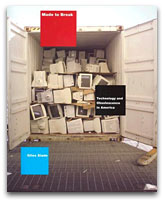What could be more American than reaching for something new? The U.S. is, after all, a nation founded on the rejection of tradition and a profound belief in invention. This urge has given us more than two centuries of powerful technology, but has also made Americans the world’s most voracious consumers. The propensity to buy, discard, and buy again is no accident, explains Giles Slade in the engaging Made to Break, which chronicles the history and consequences of Americans’ obsession with the next new thing.

The new models always suck better.
Photo: iStockphoto.
“Deliberate obsolescence in all its forms — technological, psychological, or planned — is a uniquely American invention. Not only did we invent disposable products, ranging from diapers to cameras to contact lenses, but we invented the very concept of disposability itself,” writes Slade, a Canadian cultural historian who has spent years teaching abroad and observes North American consumer culture from his home near Vancouver, B.C.
Having just written a book about high-tech trash myself, I called Slade recently to talk about the origins of this breed of consumerism. “We landed on the East Coast and had this enormous new continent to consume. We worked our way west killing things,” he said, only partly in jest. “We had an ethic of conservation and reuse, but it was lost as new materials of the 19th century allowed for disposable goods, and manufacturers learned about the profitability of repetitive consumption.”
In the late 1800s, with the advent of packaged biscuits (with brand names Uneeda and Iwanna) and paper shirtfronts (developed to satisfy demand for spotless whites from men without access to laundry), manufacturers began to realize the seemingly endless commercial potential of short-lived products. Freshness and brand name would be linked to lure repeat customers.
While some of the first disposable products were designed for men — including razor blades and condoms — it was in marketing such products to women that a whole new era in American consumption was born. In the 1920s, as society became more urban and more women entered the workforce, manufacturers — flush with surplus goods stockpiled for World War I — fully understood the potential of selling products that could be promoted as both hygienic and convenient. From Band-Aids and sanitary napkins, it was a short leap to Dixie cups and Swiffer mops.

Made to Break:
Technology and Obsolescence
in America, by Giles Slade,
Harvard University Press,
330 pgs., 2006.
Among the eye-opening revelations of Made to Break is Slade’s account of the anti-thrift campaigns launched in the wake of World War I. During the war, the U.S. Treasury Department initiated a frugality campaign opposed by wary merchants. In 1917, Slade recounts, “stores in every city began displaying signs reading, ‘Business as Usual. Beware of Thrift and Unwise Economy.'” And a few years later, New York retailers “launched the National Prosperity Committee, with posters that read ‘Full Speed Ahead!’ ‘Clear the Track for Prosperity!’ ‘Buy What You Need Now!'” (Those sentiments, I realized, were echoed 80 years later, in the grief-stricken days following Sept. 11, when President Bush exhorted Americans to “go shopping” — to show that our resolve and values had not been shaken.)
An entertaining historian with a conversational style, Slade explores the Depression-era development of marketing campaigns that encouraged rapid automobile replacement and resulted in products designed not to last — a concept called “death dating.” By the end of World War II, Americans’ self-image and esteem were entwined with the possession of the shiny and new as never before. Then, in the 1950s and ’60s, the media began touting a plethora of products whose novelty outweighed their necessity, to a growing — and increasingly affluent — audience. To this day, says Slade, “We evaluate ourselves and those around us by what they display. It’s a very hard cycle to break.”
In recent years, our embrace of technology and insatiable appetite for the new converged with planned obsolescence, as Americans’ acquisition of consumer electronics began to skyrocket. Americans now own more than 2 billion of these digital devices — with short life spans dictated by rapidly evolving semiconductors — and dispose of hundreds of millions of computers, cell phones, televisions, and other such equipment each year. Some of this equipment is truly obsolete. Some has simply been cast aside in favor of a new model. (“My son has a perfectly good MP3 player, but he wants an iPod because it’s the dead-coolest thing to have, while my father loved durability and things made to last,” Slade tells me. In the book, he pins that generational disparity on “a unique combination of psychological and technological obsolescence.”)
The result is a growing stream of hazardous waste that is gradually awakening us to the costs of our disposable society. Millions of tons of e-waste end up in U.S. landfills each year, and millions more are exported to developing countries. Some are simply dumped there, while others are recycled under unsafe, unhealthy, and environmentally hazardous conditions. Given the global nature of the business and the volume at which we’re producing and consuming PCs, cell phones, CD players, PDAs, MP3 players, and the like, the impacts are being felt worldwide.
So is there any real hope, I ask Slade? How do we undo this cycle of consumption? “A lot of really sophisticated people devoted a lot of time and thought to developing this system,” he says. “We need to look at the problem creatively and rethink it. Our whole economy is based on buying, trashing, and buying again. We need to rethink industrial design.”
In the United States, where we still cling to the myth of the endless frontier and equate progress and prosperity with the ability to jettison things, the notions of reuse and recycle have been slow to take hold. The idea of designing a product with the end of its life and impacts of its production in mind is still novel, and American businesses tend to regard the idea of producer responsibility — which holds the manufacturer responsible for a product at the end of its useful life — as a threat to profit margins. But in other parts of the world, governments and manufacturers are confronting the costs of disposability at long last.
“During the next few years, the overwhelming problem of waste of all kinds will, I believe, compel American manufacturers to modify industrial practices that feed upon a throwaway ethic,” Slade writes. “The golden age of obsolescence — the heyday of nylons, tailfins, and transistor radios — will go the way of the buffalo.”



